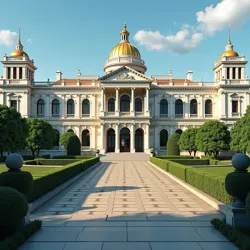The Brazilian Empire

The Imperial Palace in Rio de Janeiro, seat of the Brazilian monarchy
Rio de Janeiro
Constitutional monarchy with authoritarian characteristics
Pedro VI
11,248,320 km²
312,457,000 (2023)
Imperial Real
Portuguese
The Brazilian Empire is a vast constitutional monarchy encompassing much of northern and eastern South America, including the territories of historical Brazil, Uruguay, Suriname, Guyana, and Paraguay. Additionally, it maintains a significant colonial presence in West Africa through the Imperial African Territory. Known for its unique blend of authoritarian governance and monarchical tradition, the Empire stands as one of the world's most powerful conservative states, maintaining a political system that has evolved from its 19th-century origins while preserving core ideological elements.
 Annual military parade celebrating the Empire's founding, featuring the elite Imperial Guard units
Annual military parade celebrating the Empire's founding, featuring the elite Imperial Guard unitsHistorical Development
Imperial Consolidation (1822-1889)
The modern Brazilian Empire traces its roots to 1822, when Pedro I declared independence from Portugal. However, the crucial turning point came in the 1840s with the formation of the Conservative Trinity Alliance (Aliança da Trindade Conservadora), uniting the Catholic Church, military leadership, and conservative intellectuals. This alliance prevented the republican movements that historically dissolved other American monarchies, instead strengthening imperial authority through a careful balance of power sharing and ideological alignment.
The Empire expanded its territories through a combination of diplomatic maneuvering and military campaigns. The Platine Wars (1851-1870) resulted in the incorporation of Uruguay, while the Northern Expansion Campaign (1872-1885) brought the Guianas under imperial control. The Paraguayan Integration (1864-1870) marked the final major territorial acquisition in South America.
African Colonial Period
The Empire established its African presence during the West African Campaign of 1885-1890, securing territories that would become the Imperial African Territory. Unlike other colonial powers that eventually granted independence to their African possessions, Brazil maintained and intensified its control, developing a sophisticated system of resource extraction and labor management that continues to generate significant controversy in the international community.
Government and Politics
Constitutional Framework
The Brazilian Empire operates under the Imperial Constitution of 1884, which replaced the original 1824 constitution. This document establishes a complex power-sharing arrangement between the monarch, the Imperial Council (Conselho Imperial), and the National Congress (Congresso Nacional). The Emperor serves as both head of state and supreme military commander, while holding significant executive powers.
The Conservative Trinity
The Conservative Trinity Alliance maintains its influence through a sophisticated network of institutions:
The Catholic Church, through the Imperial Religious Council, maintains significant control over education and social policies. The military, represented by the High Command Council, directs defense policy and internal security. Conservative academia, organized through the Imperial Academy of Sciences and Culture, shapes public discourse and policy formation.
Judicial System
The Empire's judicial system operates through the Imperial Supreme Court (Supremo Tribunal Imperial) and various lower courts. The legal framework combines Portuguese civil law traditions with unique Brazilian imperial innovations, particularly in areas of social control and property rights.
Economy
Industrial-Agricultural Complex
The Brazilian Empire maintains a mixed economy with strong state involvement in strategic sectors. The Imperial Economic Development Council coordinates industrial policy, focusing on maintaining self-sufficiency in key industries while promoting export-oriented agriculture and manufacturing.
The Empire's agricultural sector, dominated by large Imperial Estates (Latifúndios Imperiais), produces significant portions of the world's coffee, soybeans, and sugar. Industrial production centers on aerospace, military equipment, and heavy machinery, with the state-owned Imperial Industrial Corporation playing a central role.
African Resource Integration
The Imperial African Territory serves as a crucial source of minerals, agricultural products, and labor for the Empire's economy. The Colonial Resource Management Authority oversees the extraction of diamonds, gold, and rare earth elements, while maintaining the controversial Imperial Labor System that human rights organizations have repeatedly criticized.
Military and Defense
Armed Forces
The Brazilian Imperial Armed Forces rank among the world's most powerful military establishments, with particular strength in naval and air capabilities. The Imperial Navy maintains significant presence in both the Atlantic and Pacific oceans, while the Imperial Air Force operates one of the largest military aviation fleets in the Western Hemisphere.
 The Brazilian Imperial Navy conducts its annual fleet review off the coast of Rio de Janeiro
The Brazilian Imperial Navy conducts its annual fleet review off the coast of Rio de JaneiroDefense Industry
The Empire maintains a sophisticated defense industry through the Imperial Defense Industries Corporation, producing everything from small arms to aircraft carriers. Strategic partnerships with other conservative nations have helped develop advanced military technologies, including nuclear capabilities.
International Relations
Strategic Alliances
The Empire maintains complex relationships with global powers, often aligning with conservative and authoritarian states while maintaining necessary economic ties with democratic nations. The Imperial Diplomatic Corps carefully balances these relationships to maintain Brazil's autonomy and influence.
Regional Hegemony
Within South America, the Empire exercises considerable influence through economic and military power. The South American Cooperation Treaty effectively places most non-Empire South American nations within Brazil's sphere of influence.
Society and Culture
Social Structure
Brazilian imperial society maintains a hierarchical structure influenced by traditional Catholic values, military discipline, and academic elitism. The Imperial Social Order system formally recognizes different social classes, with mobility primarily possible through military service, religious vocation, or academic achievement.
Education and Academia
The Empire's education system, controlled by the Imperial Education Ministry in cooperation with the Catholic Church, emphasizes traditional values, national history, and technical skills. The prestigious Imperial Universities serve as centers for conservative intellectual thought and technical innovation.
Cultural Expression
Despite its authoritarian nature, the Empire has developed a rich cultural life that blends traditional Portuguese-Brazilian elements with influences from its various territories. The Imperial Cultural Institute promotes approved forms of artistic expression while maintaining careful oversight of cultural production.
Contemporary Challenges
The Brazilian Empire faces several ongoing challenges, including international criticism of its African colonial policies, internal pressure for modernization, and the need to maintain technological competitiveness. However, the stability of the Conservative Trinity Alliance and the Empire's economic strength have thus far enabled it to maintain its unique political and social system while continuing to exercise significant global influence.
The Empire's ability to adapt while maintaining its core ideological principles will likely determine its future trajectory in an increasingly complex global environment. Current Emperor Pedro VI has indicated continued commitment to the traditional imperial system while pursuing careful modernization in selected areas, particularly technology and industrial development.